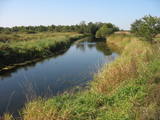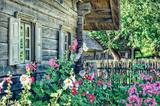| Nr | Nosaukums | Apraksts |
|---|---|---|
|
Lai mazinātu upes grīvas aizsērēšanu un regulētu tecējumu, 19. gs. vidū tika uzcelts Austrumu mols – 980 m garumā. Tā pamatu veido koka pāļu konstrukcija, kas nosegta ar akmeņiem. 2,2 km garais mols mūsdienās ir atjaunots un kalpo kā iecienīta pastaigu, atpūtas un makšķerēšanas vieta visos gadalaikos. No mola var vērot putnus, paretam var laimēties redzēt arī kādu roni. Mola sākumā apskatāmi 2 laukakmeņi, kuros iekaltais teksts vēstī, ka šo būvi apmeklējuši Krievijas imperators Aleksandrs II (1856. g.) un troņmantnieks Nikolajs Aleksandrovičs (1860. g.). Šis fakts izceļ Rīgas ostas nozīmīgumu tā laika Baltijas jūras tirdzniecības ceļu kontekstā. |
||
|
Atrodas Sēlijas paugurvaļņa vienā no augstākajiem punktiem – Borīškalnā. No atjaunotā torņa pārskatāms Saukas ezers un tam pieguļošie meži un lauksaimniecības zemes. Netālu – zemnieku saimniecība „Kalna Ļūdāni”, kuras saimnieks ar mājlopu palīdzību veido un uztur apkārtnes ainavu. |
||
|
Vecpiebalgas pagasta „Lejas Kaikašos”, rakstnieka Antona Austriņa (1884–1934) dzimtajās mājās, kopš 1990. gada durvis ver piemiņas muzejs. Šeit var iedziļināties viņa dzīvē un literārajā mantojumā, kā arī sajust laikmeta garu, kas veidojis viņa personību. „Mūsmāja nav tikai pajumte, patvērums pret lietu un vēju, viņā uzglabājies arī kāds |
||
|
Atrodas Daugavas labajā krastā, ap puskilometru no Skrīveru Zemkopības institūta. Šajā vietā stāvo Daugavas ielejas krastu „pāršķeļ” dziļā Ašķeres strauta grava. Pilskalns bijis apdzīvots jau no 1. g. t. pr. Kr., par to liecina tajā atrastas latgaļu un lībiešu senlietas. 13. gs. pilskalnā slējās mūra pils, ko nopostīja 17. gs. Par tās esamību mūsdienās nekas vairs neliecina. No pilskalna, ko dēvē arī par Kraukļu kalniem, paveras viens no skaistākajiem Daugavas vidusdaļas skatiem. No tā (Rīgas virzienā) redzama Senbaznīcas vieta (attīrīts laukums ar baltu krustu). Gar Ašķeres strauta krastiem izveidota pastaigu taka. Tuvākā pilskalna apkārtne ir labiekārtota, kopumā ir izveidotas četras takas. Garākā no tām ir Daugavas taka (10 km). |
||
|
Ekskursijas sākumā apmeklējiet Enerģētikas muzeja ekspozīciju Pļaviņu hidroelektrostacijā, kur iespējams iepazīties ar unikālās būves un lielākās elektroenerģijas ražotnes Baltijā celtniecības vēsturi un darbības nozīmīgākajiem notikumiem. Pēc tam apmeklējiet Skrīveru pārtikas kombinātu, kurā iespējams iegādāties gardās konfektes un doties ekskursijā. Tālāk - Skrīveru mājas saldējums ar stāstījumu par saldējuma gatavošanu un degustācija. Brauciena noslēgumā dodieties uz savvaļas dzīvnieku dārzu, kur dzīvo ~ 50 dambrieži un Skotijas savvaļas govis. |
||
|
Sākumā maršruts ved pie bērzu sulu un vīna izgatavotāja, un tālāk - kazu saimniecība, kur ir iespējams degustēt dažādus piena produktus un apskatīt dzīvniekus. Tālāk dodieties uz Siguldu, kur atrodas bobsleja un kamaniņu trase un trīs viduslaiku pilis - Siguldas, Turaidas un Krimuldas pils. Pēc tam iepazīstieties ar vēsturisko Līgatnes ciematu un Līgatnes papīrfabriku, apciemojiet vietējos amatniekus. Tad - Cēsis ar varenām viduslaiku pilsdrupām un Jauno pili. Apciemojiet kaņepju audzētājus un nogaršojiet kaņepes, kas pagatavotas tradicionālā veidā. Tālāk izbaudiet Ķoņu dzirnavas, kurās vilna tiek apstrādāta ar veclaicīgām iekārtām. Dodieties tālāk uz Mazsalacu, kur atrodas dabas parks ar pastaigu takām. Salacas upe ir pazīstama ar nēģiem, un maršruta laikā jums ir iespēja redzēt tradicionālos nēģu tačus. Saulkrastos izbaudiet pastaigas gar jūru. Tālāk apmeklējiet lielogu dzērveņu purvus un nogaršojiet šīs ogas. Apskatiet eleganto Bīriņu pili ar tās lielo parku un lielisko restorānu. |
||
|
Atrodas Viesītes centrā, Raiņa ielā 14. Piemiņas plāksne uz Zaļās koka mājas vēsta, ka laikā no 1902. – 1914. gadam te dzīvojis izcilais latviešu ķirurgs, akadēmiķis un profesors Pauls Stradiņš (1896. – 1958.). Piemiņas istabā apskatāmi eksponāti, kas saistīti ar P. Stradiņu un viņa dzimtu. Šobrīd piemiņas istaba ir slēgta. Plānots, ka 2013. gada tūrisma sezonā tā jau atradīsies bijušajā Viesītes skolā Peldu ielā 2.
|
||
|
Palieņu un mitrās pļavas abos Dubnas upes krastos, kuras nelielā posmā var vērot no Rožupes - Vārkavas ceļa. Piemērotā laikā šeit dzirdēsiet griezes balsi, kas ir Eiropā izzūdoša putnu suga.
|
||
|
Lauku mājā "Celmiņi" iespējams dzirdēt farmaceites Valentīnas Dāboliņas stāstus par veselību stiprinošiem ārstniecības augiem. Tiek piedāvāta augu atpazīšana un tēju vākšana, kā arī tēju degustācija un iegāde. |
||
|
Tieši pie jūras, tikai 20 minūšu brauciena attālumā no Pärnu, atrodas Kapteiņa māja (Kapteni talu), kur kapteiņa svaigi nozvejotās zivis pārtop gardos zivju ēdienos, kurus var iegādāties vai nogaršot Kapteiņa vasaras kafejnīcā. |
||
|
Bijušā piecstāvīgā metāla skatu torņa apkaimē plešas Lemmjegi upes palieņu pļavas. Netālu atrodas kādreizējā Oksas kroga (Oksa kõrts) vieta, kur saglabājies iespaidīgs manteļskurstenis. Apkaimes apskatei izveidota 0,8 km gara koka laipu taka. |
||
|
Kambīze "Pie Laša kundzes" atrodas pie Salacgrīvas tūrisma informācijas centra – vēsturiskajā zivju ledus pagrabā. Jūrniecības tēmai atbilstošs interjers. Latviešu virtuve: Aukstā biešu zupa, jūras zivju zupa, zivju un dārzeņu sacepums, šokolādes desa, pankūkas ar zemeņu ievārījumu, kvass. Īpašais ēdiens: Ceptas un grilētas zivis – asari, butes, zandarti. |
||
|
Bārs "Stender's" atrodas Kuldīgas pilsētas centrā, galvenās Kuldīgas gājēju un riteņbraucēju ielas - Liepājas ielas - sākumā, un ir izvietojies ēkā, kuras vēsture iestiepjas vairākos iepriekšējos gadu simtos, kad tā kalpoja kā graudu klēts. Bārs atrodas ēkas otrajā stāvā, ar zemākajām durvju stenderēm Kudlīgā un koka bukiem bārā. Latviešu virtuve: Zemnieku brokastis, auzu pārslu putra, aukstā kefīra zupa, skābeņu, gurķu un pupiņu zupa, liellopa gaļa sīpolu mērcē, mednieku desiņas, kartupeļu pankūkas, saldās pankūkas ar brūkleņu mērci. |
||
|
Trīs krāteri, no kuriem lielākā – Elles kapa (Põrguhaud) diametrs ir ~ 80 m, dziļums līdz 12 m. To ietver vairākus metrus augsti vaļņi. Pārējie krāteri ir dabā grūti atrodami un atpazīstami. Krāteru vecums ir ~ 6000 gadi. Līdz šim gan nav atrastas meteorīta atliekas, kas apstiprinātu to izcelsmi.
|
||
|
Viens no skaistākajiem Latvijas ābeļdārziem (~ 10 ha un 30 ābolu šķirnes), kas iekārtots iespaidīga paugura nogāzēs, no kura augšdaļas skaidrā laikā var redzēt Rīgas jūras līča ūdeņus. Īpaši skaisti šeit ir ziedošu ābeļu laikā. Piedāvā ābolus un degustācijas. |
||
|
Vienīgā šāda veida skatu platforma Latvijā, kas ir pieejama cilvēkiem ar ratiņkrēsliem. No platformas otrā stāva ir pārskatāma lielākā daļa lieguma teritorijas – plaši niedrāji, nelielas lāmas, priekškāpa un Daugavas grīva. Piemērota vieta putnu vērošanai.
|
||
|
The Palanga Botanical Garden surrounds the Palanga Amber Museum and is one of Lithuania's most beautiful and well-kept parks. It is in the area of the St Birute Forest, and it is familiarly known as the Birute Park. The park covers 101.3 ha of land, and offers a wide variety of landscapes, carefully organised trails, flowerbeds, two ponds and small architectural elements. |
||
|
This museum focuses on life in the countryside and was opened in 1991. It sits on 18 ha of land, with authentic farms from the Augštaitija region. |
||
|
The restaurant is in Bocmaņa Square in the centre of Salacgrīva and on the banks of the Salaca River. The well-known “Pie Bocmaņa” saloon has been redesigned and features the topic of Baron Munchhausen. Latvian cuisine: Herring salad, herring with cottage cheese, fish soup, breast of pork with onions, grey peas with bacon, fried livers, baked plaice, baked filet of pike-perch, stacked rye bread. |
||
|
The estate is in the centre of Ineši, 5 km to the south of Vecpiebalga. The estate dates back to the latter half of the 17th century, when an ornate castle for the noble Sheremetyev family was built here in the style of Classicism and on the banks of the little Orisāre River. The castle was built down during the 1905 Revolution, but restored four years later. Around the castle is a lovely landscape park. The castle served as the prototype for the Slātava Estate in the famous novel “Age of the Surveyors” by the Kaudzīte brothers. In 1992, the Piebalga Administrative District Museum was opened in the wine cellar of the castle, which is home to the Ineši Parish Council and a porcelain painting studio. Organised tours of the estate and its surrounding area are available. |
||






















